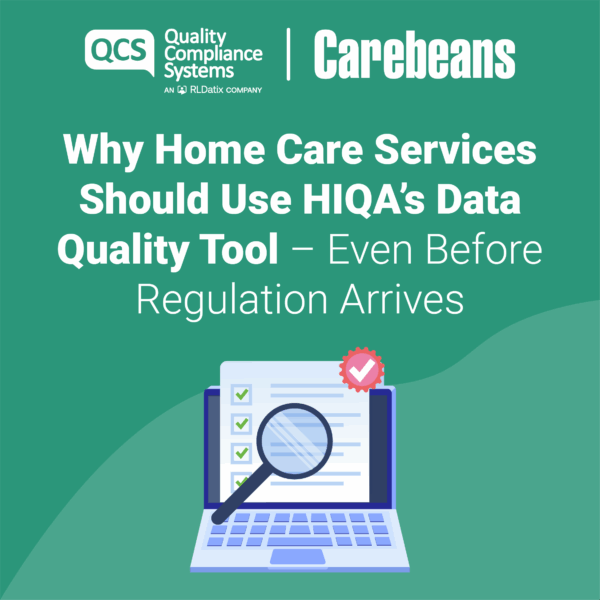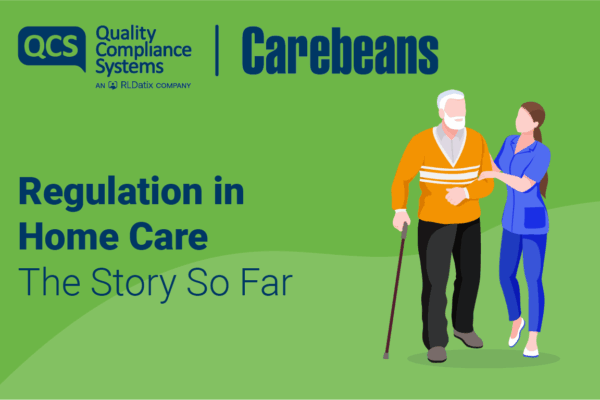Home care services in Ireland are on the cusp of major change. While not yet regulated by HIQA, statutory licensing and inspection systems aimed at bringing oversight and consistency across the sector are on the way.
So, how best to prepare? Now is the time to consider the ways you will provide evidence of best practice across all areas of your service to HIQA.
One simple and practical step is to start using the HIQA Data Quality Assessment Tool. This a free, evidence-based resource designed to help services assess and improve the quality of the data they collect and use.
Here’s why it’s worth using this tool, even before regulation is in place.
1. Get Ahead – Be ready!
Regulation and inspection are coming. By starting now, you can demonstrate leadership and readiness. Using the HIQA tool shows a proactive approach to meeting expected standards and a willingness to embrace quality improvement.
2. Better Data, Better Care
Research shows high-quality data leads to safer, more person-centred care, while incomplete or delayed records can compromise decision-making and person-centred planning. When services can trust their data, they’re better able to track changes, respond to risks, and support staff to make informed decisions.
Whether it’s scheduling visits, managing care plans, or communicating with families— clear, complete data makes a real difference.
3. Strengthen Governance and Accountability
The tool helps services examine how they collect, manage, and use data-accuracy, completeness, timeliness, and more. It’s a valuable way to strengthen governance and build confidence in your record-keeping systems-key pillars of safe care delivery.
4. Show Commitment to Best Practice
Even in the absence of regulation, many providers want to demonstrate professionalism, transparency, and quality. Using tools such as the HIQA Data Quality Tool sends a strong signal to service users, families, and commissioners that the organisation is committed to continuous improvement.
5. Prepare for a More Connected Future
Irish healthcare is moving towards greater integration and digitalisation, including shared care records and data-informed planning. Providers with strong data systems will be better placed to adapt, collaborate, and contribute to future developments.
Implementing HIQA’s Data Quality Assessment Tool
Using the HIQA Data Quality Assessment Tool in home care involves a series of steps to evaluate and improve your data management practices.
Here’s a step-by-step approach to help you implement the tool effectively:
Step 1: Understand the Components of the Tool
Before using the tool, familiarise yourself with the key components of data quality. These are:
TABLE
Step 2: Review Existing Data Practices
Assess current data collection methods:
- Understand how data is currently collected, recorded, and stored in your service. Identify the types of data being recorded (e.g., service user health information, service delivery details, caregiver notes)
- Evaluate documentation processes: Are caregivers and staff consistently following the same procedures for documenting care? Are there gaps in how data is recorded or communicated between different staff members?
- Determine data storage: How is data stored (digitally or on paper)? Is the system secure and compliant with relevant data protection laws?
Step 3: Identify Areas for Improvement
Using the tool, assess where your service may be falling short, for example:
Accuracy – Are there frequent errors in care records? For example, are care plans and daily notes documented consistently and correctly?
- Completeness – Are there missing details in patient records, such as updates to care plans, health changes, or important incidents?
- Timeliness – Are there delays in updating records? For example, are care notes recorded in a timely manner following a visit?
- Consistency – Are data standards consistently applied? For instance, do staff document care plans and assessments using the same format and terms?
- Security – Are data storage methods (e.g. files, digital systems) secure, to ensure that personal and sensitive data is protected?
Step 4: Conduct the Data Quality Assessment
- Set a baseline – Document the current state of data quality within your service, based on the tool’s criteria
- Use the assessment tool – You can conduct an internal audit looking at all the relevant categories using the HIQA tool
- Rate your service in each area (e.g. accuracy, completeness, timeliness etc.) on a scale (e.g. poor, fair, good, excellent) to clearly identify where improvements are needed
Step 5: Develop an Action Plan
Based on your assessment ratings, create an action plan that addresses the identified gaps in data quality. Your plan might include things like:
- Improvement initiatives such as providing staff training on accurate data entry, or implementing a digital record-keeping solution
- Standardising procedures – Establish clear and consistent processes for data collection and management across the team
- Timely updates – Implement a policy to ensure that data is immediately recorded immediately following delivery of care in a service user’s home, to maintain timeliness and accuracy
- Security enhancements – Review and enhance security measures, such as: password protection, encryption, secure storage) to protect sensitive data
- Regular monitoring – Set regular review dates to track data practices and to ensure ongoing compliance with standards
Step 6: Provide Training and Support
- Train staff: Ensure that all staff (including care staff and administrators) are trained on:
- The importance of data quality
- How to maintain accurate and complete records
- Security protocols for handling personal data
- Ongoing support: Provide continuous support and resources to staff to ensure they are following best practices for data collection and management
Step 7: Monitor and Review Regularly
- Conduct periodic audits – Using the HIQA tool on a regular, scheduled basis to provide evidence of:
- Oversight
- Identification of any issues in data quality
- Implementation and tracking of improvements
- Make adjustments as necessary: as you monitor the outcomes, ensure compliance with your policies based on audit findings, to help continuously improve data quality
Step 8: Ensure Compliance with GDPR
- Lastly, ensure that your data practices are fully compliant with GDPR regulations:
- Consent – Always obtain and document consent from service users for collecting and processing their personal data
- Rights of individuals – Ensure that service users’ rights (e.g. the right to access, correct, or delete data about them) are fully respected
- Data minimisation: Only collect data necessary for the care process, and ensure it is kept up-to-date
By systematically applying the Data Quality Assessment Tool to your home care service, you can improve the reliability, security, and compliance of your data practices, which in turn supports high-quality delivery of care.
Ready to Start?
You can download the tool here:
HIQA Data Quality Assessment Tool
Start small: choose one area of your service, self-assess using the tool, and build from there. It’s a simple but powerful way to improve your data and your care – and to ensure your service is HIQA-ready.






